
A Taste of the Pacific Northwest: Seafood and Farm-to-Table Dining
What's in This Article
- 1. The Cultural and Historical Context of Pacific Northwest Cuisine
- 2. Seafood: The Heart of the Pacific Northwest
- 3. Farm-to-Table Dining: A Commitment to Local and Seasonal Ingredients
- 4. Dining Culture in the Pacific Northwest
- 5. Modern Influences and Innovations in Pacific Northwest Cuisine
- 6. Tips for Travelers: Savoring the Pacific Northwest's Culinary Delights
- Frequently Asked Questions
The Pacific Northwest, known for its lush landscapes, diverse ecosystems, and vibrant cities, is also a culinary paradise. The region, spanning from Northern California up through Oregon, Washington, and into British Columbia, boasts a rich food culture deeply rooted in its natural surroundings. Among the culinary traditions of this area, seafood and farm-to-table dining stand out as pillars of its gastronomic identity.
With its proximity to the Pacific Ocean and abundance of freshwater sources, the region offers some of the finest seafood in North America. Meanwhile, the temperate climate and fertile valleys provide ideal conditions for farming, fostering a strong farm-to-table movement that celebrates local, seasonal ingredients.
In this post, we'll explore the unique flavors of the Pacific Northwest, from its pristine seafood to its fresh, locally sourced produce, revealing why this region is a must-visit destination for food lovers. Whether you're planning a culinary adventure or simply curious about regional American cuisine, this guide will introduce you to the distinctive tastes and traditions that define Pacific Northwest dining.
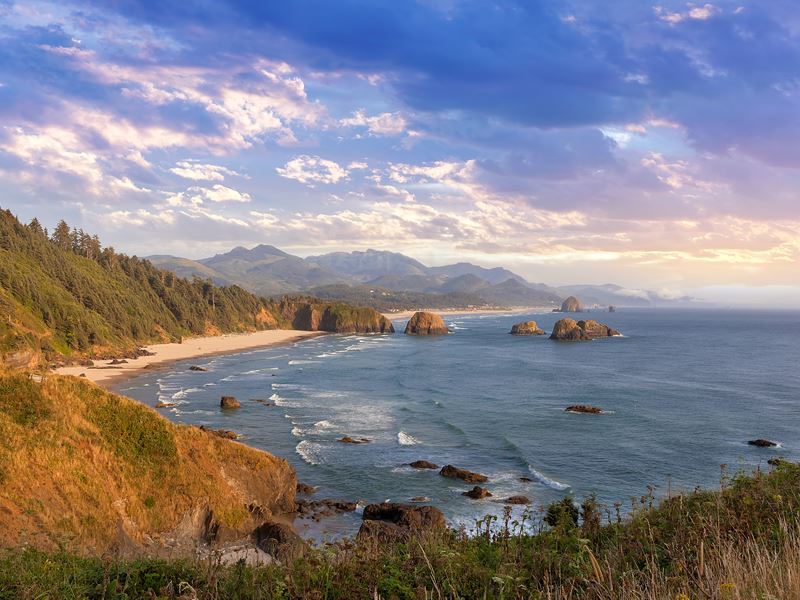
The stunning Pacific Northwest coastline, where diverse ecosystems create a unique culinary environment
1. The Cultural and Historical Context of Pacific Northwest Cuisine
The culinary traditions of the Pacific Northwest are shaped by the region's rich history and its diverse population. Indigenous communities, including the Coast Salish, Tlingit, and Haida peoples, have harvested the bounty of the land and sea for thousands of years. Salmon, shellfish, wild berries, and root vegetables have long been staples, and traditional preservation methods like smoking and curing have influenced modern culinary practices.
These indigenous food traditions highlight a deep respect for nature and sustainability that continues to influence the region's cooking philosophy today. Annual salmon runs were not just a source of food but central to cultural ceremonies and community gatherings, establishing the spiritual importance of food that characterizes Pacific Northwest cuisine.
With European settlement in the 19th century, the cuisine of the Pacific Northwest began to evolve. Immigrants from Scandinavia, Japan, China, and other parts of the world brought their own culinary traditions, integrating them with local ingredients and techniques. Scandinavian influences can be seen in the popularity of smoked fish, while Japanese culinary traditions have contributed to the region's appreciation for simple, elegant preparations that highlight the natural flavors of ingredients.
Today, the Pacific Northwest is celebrated for its commitment to sustainability and local sourcing. The farm-to-table movement, which emphasizes seasonal, locally sourced ingredients, has become a cornerstone of the region's food culture, driven by an abundance of fertile land and a year-round growing season. This approach not only produces exceptional flavors but also supports local economies and reduces the environmental impact of food production.
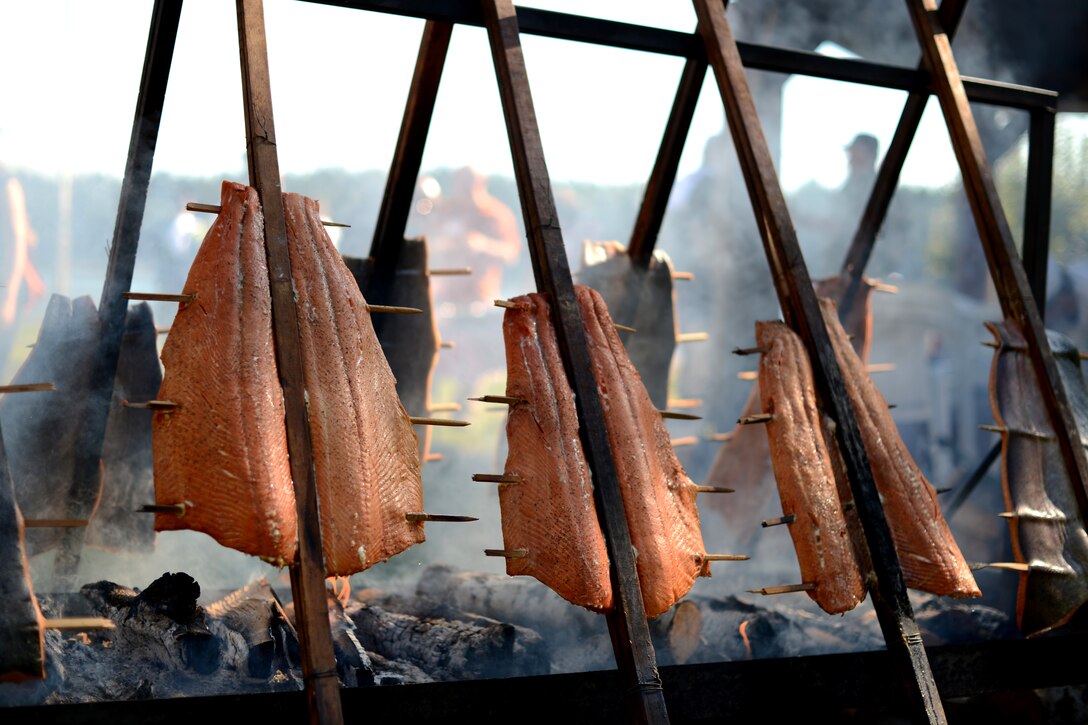
Indigenous cooking techniques have influenced modern Pacific Northwest cuisine for generations
2. Seafood: The Heart of the Pacific Northwest
The Pacific Northwest's proximity to the Pacific Ocean and its many rivers and lakes make it a haven for seafood lovers. The waters here are cold and clean, providing an ideal environment for a variety of fish and shellfish that are celebrated for their exceptional quality and flavor.
From the rugged coastlines of Oregon to the sheltered waters of Puget Sound, seafood is more than just food—it's a central part of the region's identity. Local fishing communities maintain centuries-old traditions while embracing sustainable practices to ensure these precious resources endure for future generations.
Key Seafood Delicacies of the Pacific Northwest
Salmon: Perhaps the most iconic Pacific Northwest seafood, wild salmon—such as Chinook, Coho, and Sockeye—are prized for their flavor and texture. Traditional cooking methods, such as cedar plank grilling or smoking, are popular ways to enjoy this fish. At Salish Lodge & Spa near Seattle, diners can experience salmon prepared with traditional indigenous techniques alongside spectacular waterfall views.
Dungeness Crab: This sweet, tender crab is found in abundance along the coast, often served with melted butter or used in crab cakes and seafood stews. The meaty claws and body segments contain delicate flesh that requires minimal seasoning to shine.
Oysters: The region's cold waters produce some of the best oysters in the world, including the briny Olympia and the plump Pacific varieties. Oysters are often served raw, grilled, or even in chowders. Each bay and inlet produces oysters with distinct flavor profiles, influenced by the specific mineral content and tidal patterns of their environment.
Halibut: This firm white fish is a versatile staple, appearing in everything from fish and chips to elegant entrees with seasonal vegetables. Pacific halibut is known for its clean taste and substantial texture that holds up well to various cooking methods.
Geoduck: Pronounced "gooey-duck," this unique giant clam has a mild, sweet flavor and a crunchy texture, often served as sashimi or in chowders. Though intimidating in appearance, this distinctive shellfish is considered a delicacy both regionally and internationally, particularly in East Asian cuisines.
Sustainable Seafood Practices
The Pacific Northwest places a strong emphasis on sustainable fishing practices. Organizations like the Marine Stewardship Council and local fisheries collaborate to ensure that the seafood harvested from the region is done so responsibly, preserving fish populations and protecting the marine ecosystem. Diners will often find restaurants listing the sources of their seafood, with designations such as "line-caught" or "wild-caught" signaling a commitment to sustainability.
Many establishments in the region, like Ray's Boathouse in Seattle, have been pioneers in the sustainable seafood movement, working directly with fishermen who use environmentally friendly harvesting methods. This commitment extends beyond restaurants to markets and educational programs that teach consumers how to make responsible seafood choices.
The sustainable seafood movement in the Pacific Northwest also addresses the critical issue of salmon conservation. With wild salmon populations facing challenges from habitat loss and climate change, many restaurants and suppliers participate in salmon recovery initiatives that protect spawning grounds and support the long-term health of these iconic fish.
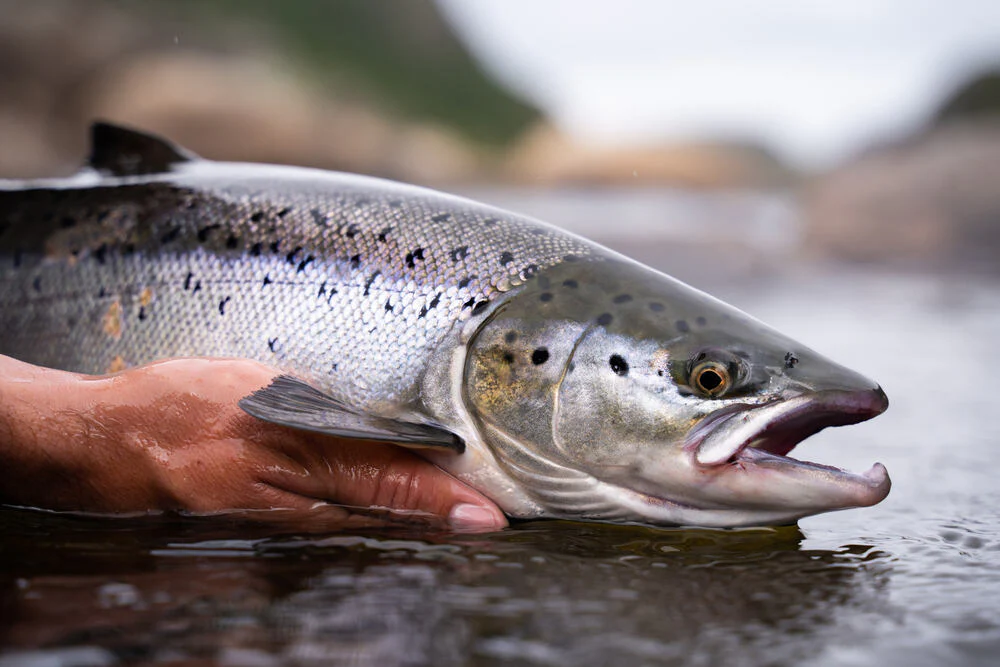
Wild salmon is the cornerstone of Pacific Northwest seafood cuisine, prized for its rich flavor and cultural significance
3. Farm-to-Table Dining: A Commitment to Local and Seasonal Ingredients
The farm-to-table movement is a major component of the Pacific Northwest's culinary landscape. The region's climate, with its abundant rainfall and fertile soil, supports a wide variety of crops, from lush greens and root vegetables to berries and apples. Farmers' markets are a staple of local communities, and many restaurants have direct relationships with nearby farms, ensuring that diners receive the freshest produce possible.
This commitment to local ingredients isn't just about flavor—it's also about supporting small-scale agriculture and reducing the environmental impact of food transportation. Chefs throughout the region take pride in knowing the exact origin of their ingredients, often visiting farms personally to select produce and develop menus around what's currently available.
The region's moderate climate allows for an extended growing season, with different microclimates supporting a diverse range of crops. From the coastal farms of Oregon to the eastern agricultural regions of Washington, each area contributes its own distinctive produce to the Pacific Northwest's culinary palette.
Key Ingredients in Pacific Northwest Farm-to-Table Cuisine
Mushrooms: Wild mushrooms like chanterelles, morels, and porcinis are foraged in the region's forests, offering earthy flavors that complement many dishes. After autumn rains, local foragers supply restaurants with these prized fungi, which often feature prominently on seasonal menus.
Berries: The Pacific Northwest is home to an array of berries, including blackberries, blueberries, huckleberries, and marionberries. These fruits are featured in desserts, sauces, and even savory dishes. Wild blackberry bushes grow abundantly throughout the region, and picking these fruits is a beloved summer activity for locals.
Apples: Washington State, known as the "Apple Capital of the World," grows dozens of apple varieties that are celebrated in pies, ciders, and fresh preparations. Orchards throughout the region offer u-pick experiences and farm stands where visitors can taste heirloom varieties rarely found in supermarkets.
Hazelnuts: Oregon is a leading producer of hazelnuts, which are used in everything from salads to pastries, adding a distinctive crunch and flavor. Local chefs incorporate these nuts into pestos, crusts for fish, and innovative desserts that highlight their unique taste.
Greens and Root Vegetables: Kale, spinach, and Swiss chard are popular in local dishes, as are carrots, beets, and potatoes, which thrive in the Pacific Northwest's temperate climate. Year-round farmers' markets showcase the changing selection of vegetables, from spring's tender greens to winter's hearty roots.
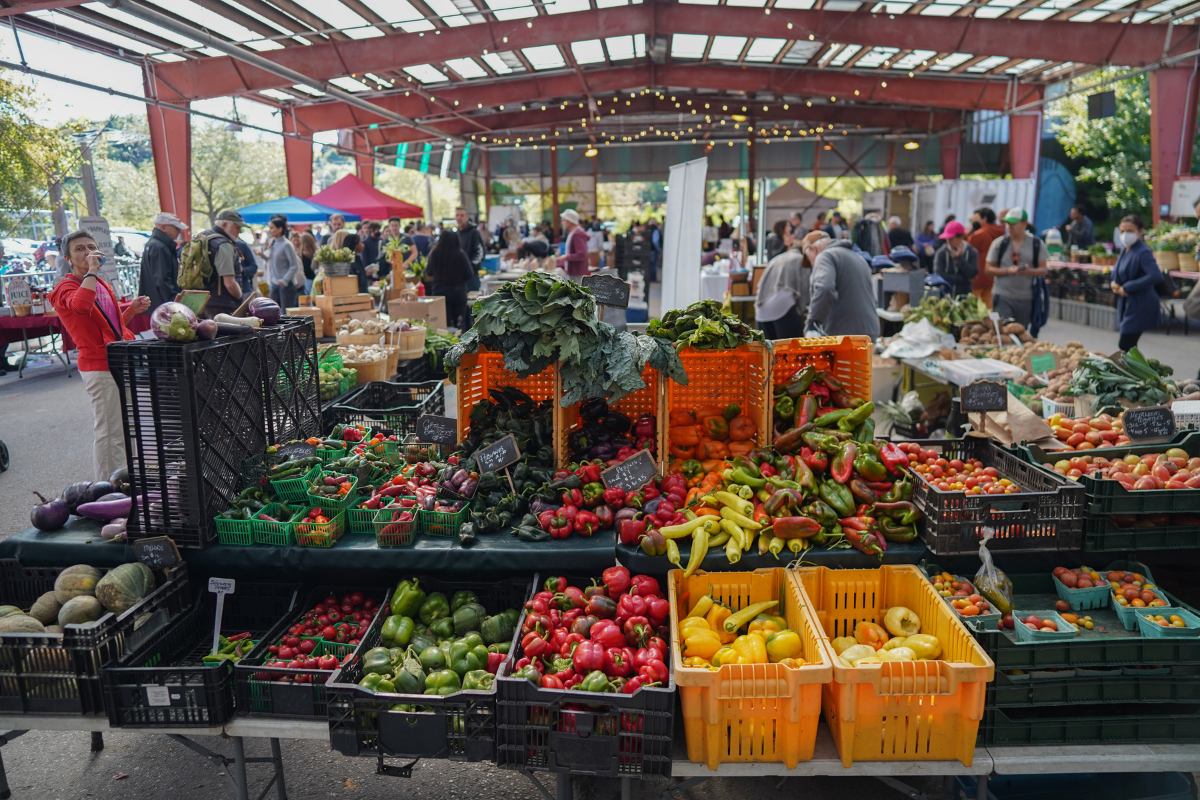
Pacific Northwest farmers markets showcase the region's commitment to fresh, seasonal ingredients
4. Dining Culture in the Pacific Northwest
Dining in the Pacific Northwest is a relaxed and unpretentious experience, focusing on quality ingredients rather than elaborate presentations. Here, dining is as much about enjoying the atmosphere as it is about savoring the food. Many restaurants boast cozy interiors with woodsy décor or outdoor seating that allows diners to take in the region's stunning landscapes.
At Sky City at the Space Needle in Seattle, guests can enjoy panoramic views alongside dishes featuring local ingredients, epitomizing the Pacific Northwest's approach to dining as a multisensory experience that connects visitors to the natural environment.
A typical meal might start with an appetizer of local oysters or a salad with fresh greens, followed by a main course featuring grilled salmon or a seasonal vegetable medley. Pairing options often include locally crafted beers or wines from Washington or Oregon's renowned vineyards, with an emphasis on local and organic selections.
The dining culture also reflects the region's casual, outdoorsy lifestyle. Even high-end restaurants rarely enforce strict dress codes, and diners are encouraged to linger over their meals, enjoying conversation and community. This relaxed approach doesn't diminish the quality or creativity of the food—rather, it creates an environment where exceptional cuisine can be appreciated without pretense.
Seasonal Dining
In keeping with the farm-to-table ethos, many restaurants in the Pacific Northwest change their menus with the seasons. In spring, you might find dishes featuring fresh asparagus and peas, while summer menus often highlight tomatoes, berries, and fresh herbs. Fall brings hearty ingredients like squash and root vegetables, and winter menus may feature roasted meats, mushrooms, and warming soups.
This seasonal approach ensures that ingredients are enjoyed at their peak flavor while also creating a dynamic dining scene that reflects the changing natural environment. Regular visitors to Pacific Northwest restaurants can experience entirely different menus throughout the year, with each season offering its own distinctive culinary highlights.
Seasonal dining also extends to celebrating annual harvests and food events. Salmon festivals mark the return of spawning fish, while berry festivals in summer and mushroom celebrations in fall create community gatherings centered around iconic regional ingredients. These events connect diners to the agricultural and natural cycles that shape Pacific Northwest cuisine.
5. Modern Influences and Innovations in Pacific Northwest Cuisine
While traditional ingredients remain central to Pacific Northwest cuisine, the region is also known for its innovative culinary approaches. Chefs often experiment with fusion flavors, incorporating elements from Japanese, Korean, and other Asian cuisines, which reflect the area's rich cultural diversity.
In Tofino, British Columbia, the popular Tacofino restaurant blends Pacific Northwest ingredients with Mexican techniques, creating unique dishes like salmon tacos with locally foraged ingredients—a perfect example of the creative fusion happening across the region.
The culinary scene continues to evolve as new generations of chefs bring fresh perspectives while maintaining a deep respect for the region's food traditions and commitment to sustainability. Pop-up dining experiences, food trucks, and experimental restaurants contribute to a dynamic food culture that balances innovation with tradition.
Modern Trends in Pacific Northwest Dining
Foraging: Many chefs forage for wild ingredients, like nettles, wild greens, and edible flowers, adding unique flavors and textures to their dishes. Guided foraging tours have become popular experiences for visitors wanting to learn about the region's edible natural resources.
Fermentation: Pickling and fermenting are popular techniques, used to create tangy accompaniments or to preserve the harvest. Fermented vegetables, sourdough bread, and kombucha are common. Experimental fermentation labs in Portland and Seattle push the boundaries of traditional preservation methods, creating innovative flavors from local ingredients.
Plant-Based Dining: With an abundance of fresh produce, the Pacific Northwest is a hub for plant-based and vegan cuisine. Many restaurants offer creative vegetarian dishes that highlight local ingredients, making the region particularly welcoming for those following plant-based diets. These establishments prove that exceptional dining experiences don't require animal products when seasonal, local vegetables are prepared with creativity and skill.
Craft Beverages: The region is famous for its craft beer scene, with countless breweries producing everything from hoppy IPAs to rich stouts. Additionally, there is a growing interest in craft distilleries, which produce artisanal spirits like gin and whiskey using locally sourced botanicals. The wine regions of Washington and Oregon continue to gain international recognition, particularly for cool-climate varieties like Pinot Noir and Riesling.
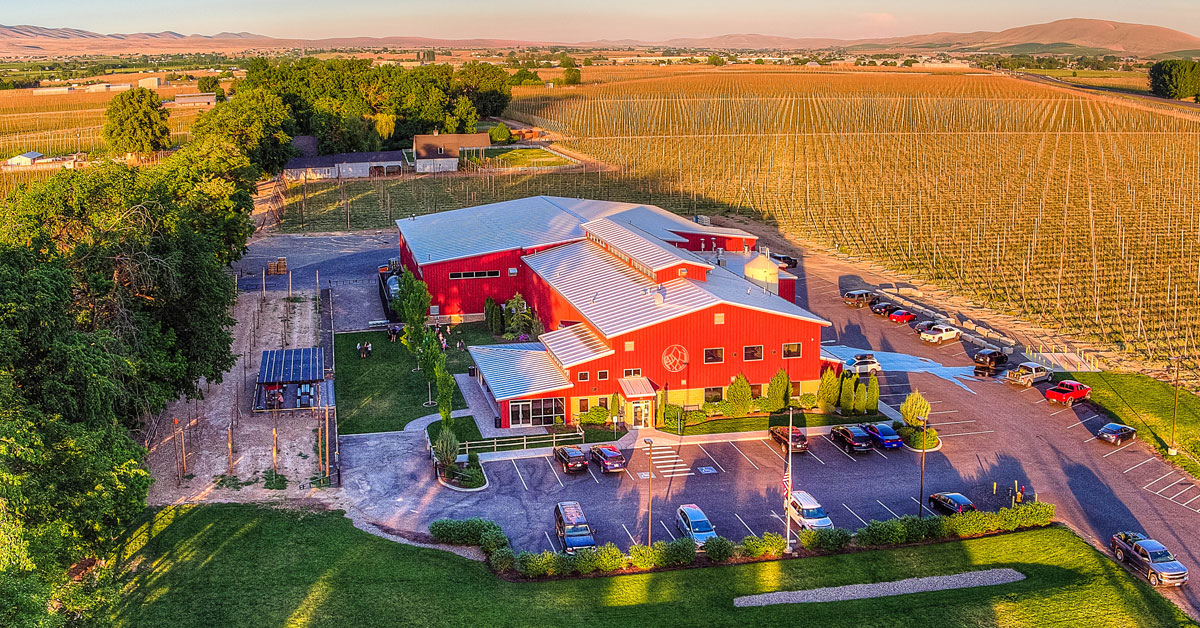
The region's thriving craft beverage scene complements its innovative culinary traditions
6. Tips for Travelers: Savoring the Pacific Northwest's Culinary Delights
If you're planning a trip to the Pacific Northwest, here are a few tips to make the most of your culinary adventure:
Travel Tips for Food Lovers
Visit Farmers' Markets: Farmers' markets are the best places to experience the farm-to-table philosophy firsthand. You'll find fresh produce, handmade cheeses, and baked goods, often alongside food trucks and local artisans. Seattle's Pike Place Market and Portland's PSU Farmers Market are iconic destinations, but smaller community markets throughout the region offer authentic local experiences.
Try a Seafood Feast: Many coastal towns have seafood shacks or waterfront restaurants where you can sample the day's catch. Be sure to try a seafood boil or clam chowder for a quintessential experience. Ask locals for recommendations on where to find the freshest seafood, as these spots may be tucked away from main tourist areas.
Tour a Vineyard or Brewery: Washington and Oregon are known for their world-class wines, especially Pinot Noir, Riesling, and Chardonnay. Many vineyards and breweries offer tastings and tours. The Willamette Valley in Oregon and Woodinville in Washington provide concentrated areas where visitors can experience multiple tasting rooms in a day.
Embrace the Rain: The Pacific Northwest is known for its wet climate, but don't let that deter you. The rain contributes to the region's lush environment and delicious produce. Just bring a raincoat and enjoy the cozy vibes of dining in a rustic restaurant while watching the rainfall outside.
Look for Seasonal Specials: Many restaurants change their menus with the seasons. Ask about the day's specials to get a taste of what's fresh and in season. Talking with servers about local specialties can lead to memorable dining experiences that showcase the region's current harvest.
Explore Food Festivals: Throughout the year, the Pacific Northwest hosts numerous food festivals celebrating everything from seafood to berries to craft beer. These events offer excellent opportunities to sample a wide variety of local specialties in one location while enjoying the community atmosphere that defines the region's food culture.
Conclusion
The Pacific Northwest offers a unique culinary experience that combines the best of the land and sea with a commitment to sustainability and local sourcing. Whether you're savoring fresh seafood at Ray's Boathouse, exploring a bustling farmers' market, or dining at a farm-to-table restaurant in British Columbia, you'll find that every bite reflects the region's natural beauty and diverse cultural heritage.
By embracing both tradition and innovation, the Pacific Northwest has crafted a food culture that celebrates its roots while continuously evolving. The indigenous respect for seasonal harvesting, immigrant culinary influences, and modern commitment to sustainability have combined to create a distinctive regional cuisine that feels both timeless and contemporary.
For travelers and locals alike, this region offers a rich and rewarding culinary journey that's sure to satisfy any food lover's appetite. The connection between food, community, and environment is palpable throughout the Pacific Northwest, creating dining experiences that nourish both body and spirit.
So next time you're in the Pacific Northwest, take the time to savor its flavors and experience its unique dining culture—you won't be disappointed. From high-end restaurants with spectacular views to humble roadside seafood shacks, the region invites you to slow down, connect with your surroundings, and appreciate the extraordinary bounty that makes Pacific Northwest cuisine truly special.

Dining with a view: many Pacific Northwest restaurants offer stunning natural vistas to enhance the culinary experience
Frequently Asked Questions
The essential Pacific Northwest seafood experiences include wild-caught salmon (especially when cedar-plank grilled), fresh Dungeness crab, raw oysters from local waters, halibut prepared in various ways, and geoduck for the adventurous eater. Each of these highlights the pristine quality of the region's seafood. Many locals also recommend trying a traditional seafood boil or authentic clam chowder at coastal establishments where the catch is brought in daily.
Late summer to early fall (August through October) offers the most abundant harvests and pleasant weather conditions. During this period, you'll find farmers' markets overflowing with produce, seafood at its peak quality, and many food festivals celebrating the harvest. Berry season peaks in summer, while mushroom foraging is best in fall after the autumn rains. However, each season offers its own culinary highlights, with spring bringing tender greens and seafood specialties and winter featuring hearty comfort foods and holiday traditions.
Look for restaurants that explicitly state their commitment to sustainable seafood practices on their menus or websites. Many establishments will list the specific source of their seafood, use terms like "line-caught" or "sustainably harvested," and may display certifications from organizations like the Marine Stewardship Council or Seafood Watch. Don't hesitate to ask your server about the origin of the seafood—most Pacific Northwest restaurants take pride in their sourcing and are happy to share this information. For a hands-on approach, visit local fishmongers who can explain their sustainable practices and recommend in-season options.
Farmers' markets offer affordable ways to sample local specialties, with many featuring food stalls serving dishes made from market ingredients. Food trucks and casual seafood shacks often provide authentic flavors at lower prices than sit-down restaurants. Consider lunch specials at high-end restaurants, which may offer similar quality to dinner service at reduced prices. Happy hours are popular throughout the region, with discounted small plates and local beverages. Finally, visiting u-pick farms for berries or apples provides both an activity and fresh produce at a fraction of retail costs.
Indigenous influence is foundational to Pacific Northwest cuisine, particularly in seafood preparation techniques like cedar plank salmon cooking, smoking methods, and preservation practices. Traditional ingredients including wild berries, foraged plants, and root vegetables remain central to regional cooking. The indigenous philosophy of seasonal eating and sustainable harvesting directly informs the modern farm-to-table movement. Some restaurants specifically highlight First Nations culinary traditions through dedicated menu items or educational dining experiences, allowing visitors to understand the deep historical roots of Pacific Northwest food culture.